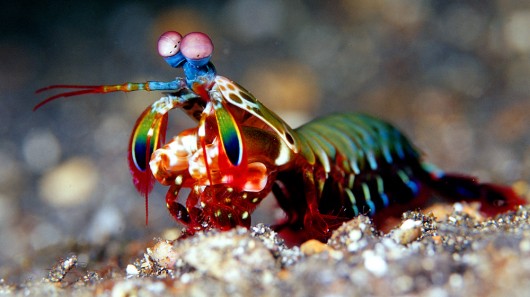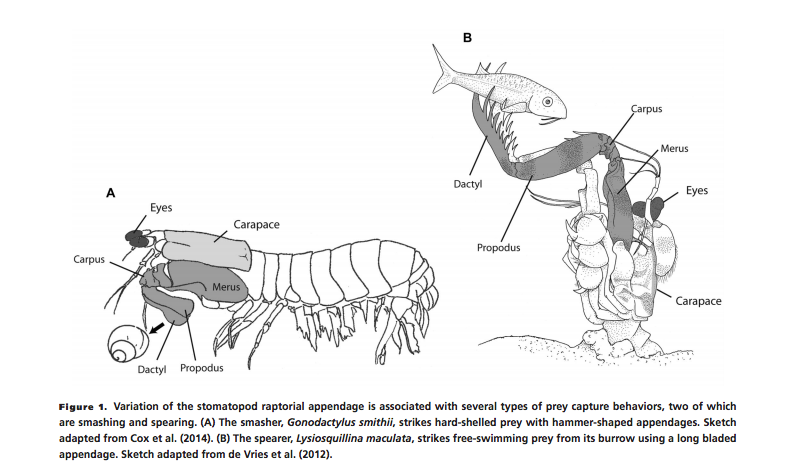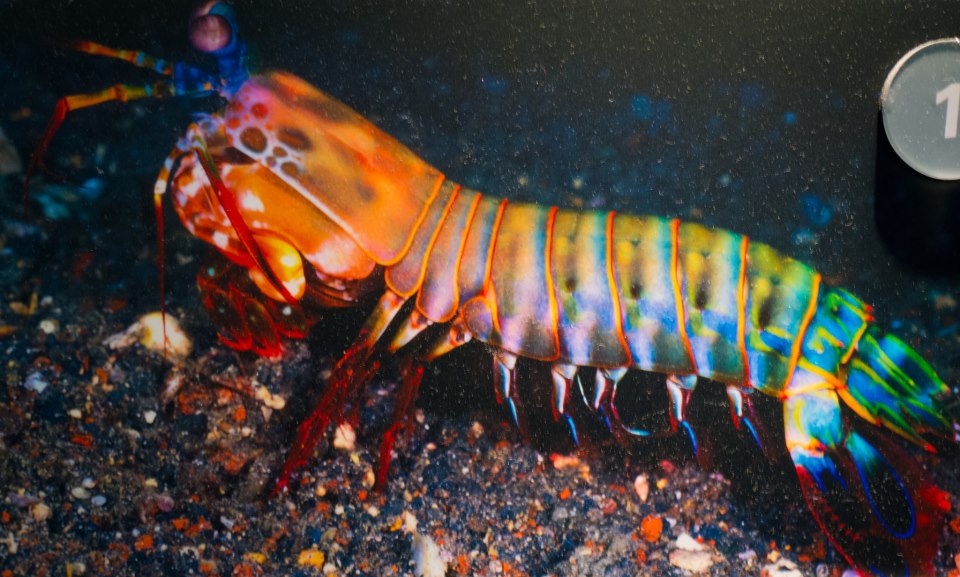Mantis Shrimp
Leah Cepko & Mason Kennon
Reed College: Biology Department (Animal Behavior - Fall 2014)

Adaptive Value
Please watch the following video of the Peacock mantis shrimp attacking prey before reading more...
Adaptive value refers to the role a given behavior has in increase the lifetime fitness of an organism.
While the general function of the mantis shrimp raptorial appendage in capturing prey is conserved across species, differences in the specific function of the raptorial appendage in striker and smasher species related to prey capture are indicative of niche specialization.

Image is Figure 1 in Anderson et al 2014 (Evolution article)
Function of Striker’s Spear
The raptorial appendage of striker species is used to impale prey from large distances from the body. During hunting, striker species remain motionless, concealed under sediment, waiting for potential prey to pass by. Their diet consists mainly of soft-bodied, mobile species captured in this manner. Once a prey item is detected by an individual (facilitated by the well-documented complexity of the mantis shrimp eye) striker species quickly release the spring mechanism of the raptorial appendage, accelerating their spear towards an evasive prey item which may be struck several body lengths from an individual (Anderson et al 2014). Success in hunting in this manner depends on the ability of an individual to quickly respond to and strike prey from relatively large distances. The selective pressures related to this strategy have led to the development of a long, thin appendage with sharp spines, commonly referred to as a spear. Anatomical adaptation from the ancestral condition has resulted in tissues organized to maximize striking distance and minimize loading time (Patek et al 2007). Such adaptions allow hidden, motionless strikers to quickly respond to a stimulus, load the raptorial spring, and impale a moving prey item.
Function of Smasher’s Hammer
In contrast to the sedentary hunting strategy of strikers, smasher species are mobile foragers. Smashers actively seek out prey, typically hard-shelled sedentary species. Such a strategy is coupled with adaption of the smasher appendage from the striker’s spear appendage to allow for the production of more force and larger accelerations (Anderson et al 2014). In fact, smasher species are capable of producing significantly larger force outputs than any other recorded mantis shrimp species group. These increases in force and speed of the appendage are achieved at the cost of a longer loading period and shorter range. However, these constraints are not particularly relevant considering the foraging strategy of smasher species. Because smashers capitalize on sedentary prey, there is far less selective pressure on spring loading time or range (Blanco et al 2014). The main constraining factor on the smasher foraging strategy is the hardness of their prey’s shell. Consequently, evolution of the smasher appendage has led to morphology organized to produce and withstand extremely large forces across short distances (Weaver et. al 2012). Smashers forage across larger areas than strikers searching for prey. Such selective pressures, specific to the foraging strategy of smasher species, have shaped the independent evolution of the hammer appendage.
Image courtesy of Michael Cann
Divergence in the Function of the Raptorial Appendage in Mantis Shrimp
Divergence of mantis shrimp raptorial appendage usage is driven by differences in the hunting strategy of the species group (Blanco et al 2014). Strikers have evolved long, sharp appendages, which can be released across large distances after a short loading time. Smashers have evolved large, durable appendages capable of producing and withstanding enormous force outputs across short distances (Weaver et al 2012). The striker appendage is well adapted for use in its sedentary strategy and the hammer appendage allows smashers to efficiently capitalize on hard-shelled prey items. It is evident that niche specialization has led to divergence in the function of the raptorial appendage in different prey capturing systems.
